Deformation Processes, Textural Evolution and Weakening in Retrograde Serpentinites
Abstract
1. Introduction
2. Main Deformation Mechanisms in Serpentine Minerals and Serpentinites
2.1. Brittle Fracturing, Cataclasis and Grain Size Reduction
2.2. Easy Sliding Along (001)
2.3. “Fibre on Fibre” Sliding Mechanism in Fibrous Serpentine
2.4. Dissolution and Precipitation
3. Friction Coefficients of Serpentine Minerals and Serpentinites
4. A Focus on Deformation in Retrograde Serpentinites
4.1. The Starting Material: Retrograde Pseudomorphic Serpentinites from the Meso- to the Nano-Scale
4.2. Stress Response in Retrograde Pseudomorphic Serpentinites
4.2.1. Deformation Mechanisms in Mesh Textured Serpentinites
4.2.2. Deformation Mechanisms in Bastites
5. The Role of Serpentine Veins
5.1. Ultraweak Fibrous Serpentine Veins
5.2. The Puzzling Case of Antigorite Splintery Veins
6. Discussion and Conclusions
Author Contributions
Acknowledgments
Conflicts of Interest
References
- Reinen, L.A.; Weeks, J.D.; Tullis, T.E. The frictional behaviour of serpentinite: Implications for aseismic creep on shallow crustal faults. Geophys. Res. Lett. 1991, 18, 1921–1924. [Google Scholar] [CrossRef]
- Moore, D.E.; Lockner, D.A.; Summers, R.; Shengli, M.; Byerlee, J.D. Strength of chrysotile-serpentinite gouge under hydrothermal conditions: Can it explain a weak San Andreas fault? Geology 1996, 24, 1041–1044. [Google Scholar] [CrossRef]
- Moore, D.E.; Lockner, D.A.; Summers, R.; Byerlee, J.D.; Ma, S. Sample characterizations and strength measurements of serpentinite gouges. US Geol. Surv. Open-File Rep. 1996, 96–702. [Google Scholar]
- Escartin, J.; Hirth, G.; Evans, B.W. Strength of slightly serpentinized peridotites: Implications for the tectonics of oceanic lithosphere. Geology 2001, 29, 1023–1026. [Google Scholar] [CrossRef]
- Moore, D.E.; Rymer, M.J. Talc-bearing serpentinite and the creeping section of the San Andreas fault. Nature 2007, 448, 795–797. [Google Scholar] [CrossRef] [PubMed]
- Amiguet, E.; Reynard, B.; Caracas, R.; Van de Moortele, B.; Hilariet, N.; Wang, Y.B. Creep of phyllosilicates at the onset of plate tectonics. Earth Planet. Sci. Lett. 2012, 345, 142–150. [Google Scholar] [CrossRef]
- Peacock, S.M. Are the lower planes of double seismic zones caused by serpentine dehydration in subducting oceanic mantle? Geology 2001, 29, 299–302. [Google Scholar] [CrossRef]
- Dobson, D.P.; Meredith, P.G.; Boon, S.A. Simulation of subduction zone seismicity by dehydration of serpentine. Science 2002, 298, 1407–1410. [Google Scholar] [CrossRef] [PubMed]
- Jung, H.; Green, H.W. Experimental faulting of serpentinite during dehydration: Implications for earthquakes, seismic low-velocity zones, and anomalous hypocenter distributions in subduction zones. Int. Geol. Rev. 2004, 46, 1089–1102. [Google Scholar] [CrossRef]
- Chollet, M.; Daniel, I.; Koga, K.T.; Morard, G.; van der Moortele, B. Kinetics and mechanism of antigorite dehydration: Implications for subduction zone seismicity. J. Geophys. Res. 2011, 166, B04203. [Google Scholar] [CrossRef]
- Reynard, B. Serpentine in active subduction zones. Lithos 2013, 178, 171–185. [Google Scholar] [CrossRef]
- Hirth, G.; Guillot, S. Rheology and tectonic significance of serpentinite. Elements 2013, 9, 107–113. [Google Scholar] [CrossRef]
- Amiguet, E.; Van De Moortele, B.; Cordier, P.; Hilariet, N.; Reynard, B. Deformation mechanisms and rheology of serpentines in experiments and in nature. J. Geophys. Res. Solid Earth 2014, 119, 4640–4655. [Google Scholar] [CrossRef]
- Guillot, S.; Schwartz, S.; Reynard, B.; Agard, P.; Prigent, C. Tectonic significance of serpentinites. Tectonophysics 2015, 646, 1–19. [Google Scholar] [CrossRef]
- Maltman, A.J. Serpentinite textures in Anglesey, North Wales, United Kingdom. Geol. Soc. Am. Bull. 1978, 89, 972–980. [Google Scholar] [CrossRef]
- Norrel, G.T.; Teixell, A.; Harper, G.D. Microstructure of serpentinite mylonites from the Josephine ophiolite and serpentinization in retrogressive shear zones, California. Geol. Soc. Am. Bull. 1989, 101, 673–682. [Google Scholar] [CrossRef]
- Hoogerduijin Strating, E.H.; Visser, R.L.M. Structures in natural serpentinite gouges. J. Struct. Geol. 1994, 16, 1205–1215. [Google Scholar] [CrossRef]
- Hermann, J.; Muntener, O.; Scambelluri, M. The importance of serpentinite mylonites for subduction and exhumation of oceanic crust. Tectonophysics 2000, 327, 225–238. [Google Scholar] [CrossRef]
- Andreani, M.; Boullier, A.-M.; Gratier, J.-P. Development of schistosity by dissolution-crystallization in a Californian serpentinite gouge. J. Struct. Geol. 2005, 27, 2256–2267. [Google Scholar] [CrossRef]
- Auzende, A.-L.; Guillot, S.; Devouard, B.; Baronnet, A. Serpentinites in an Alpine convergent setting: Effects of metamorphic grade and deformation on microstructures. European J. Miner. 2006, 18, 21–33. [Google Scholar] [CrossRef]
- Hirauchi, K.; Yamaguchi, H. Unique deformation processes involving the recrystallization of chrysotile within serpentinite: Implications for aseismic slip events within subduction zones. Terra Nova 2007, 19, 454–461. [Google Scholar] [CrossRef]
- Bellot, J.-P. Natural deformation related to serpentinization of an ultramafic inclusion within a continental shear zone: The key role of fluids. Tectonophysics 2008, 449, 133–144. [Google Scholar] [CrossRef]
- Raleigh, C.B.; Paterson, M.S. Experimental deformation of serpentinite and its tectonic implications. J. Geophys. Res. 1965, 70, 3965–3985. [Google Scholar] [CrossRef]
- Escartin, J.; Hirth, G.; Evans, B.W. Nondilatant brittle deformation of serpentinites: Implications for the Morh-Coulomb theory and the strength of faults. J. Geophys. Res. 1997, 102, 2897–2913. [Google Scholar] [CrossRef]
- Hirose, T.; Bystricky, M.; Kunze, K.; Stunitz, H. Semi-brittle flow during dehydration of lizardite-chrysotile serpentinite deformed in torsion: Implications for the rheology of oceanic lithosphere. Earth Planet. Sci. Lett. 2006, 249, 484–493. [Google Scholar] [CrossRef]
- Chernak, L.J.; Hirth, G. Deformation of antigorite serpentinite at high temperature and pressure. Earth Planet. Sci. Lett. 2010, 296, 23–33. [Google Scholar] [CrossRef]
- Hirauchi, K.; Katayama, I.; Uehara, S.; Miyahara, M.; Takai, Y. Inhibition of subduction thrust earthquakes by low-temperature plastic flow in serpentine. Earth Planet. Sci. Lett. 2010, 295, 349–357. [Google Scholar] [CrossRef]
- Mugnaioli, E.; Logar, M.; Mellini, M.; Viti, C. Complexity in 15- and 30-sectors polygonal serpentine: Longitudinal sections, intrasector stacking faults, cyclic twins and XRPD satellites. Am. Miner. 2007, 92, 603–616. [Google Scholar] [CrossRef]
- Andreani, M.; Grauby, O.; Baronnet, A.; Munoz, M. Occurrence, composition and growth of polyhedral serpentine. European J. Miner. 2008, 20, 159–171. [Google Scholar] [CrossRef]
- Reinen, L.A.; Weeks, J.D.; Tullis, T.E. The frictional behavior of lizardite and antigorite serpentinites: Experiments, constitutive models, and implications for natural faults. Pure Appl. Geophys. 1994, 143, 317–358. [Google Scholar] [CrossRef]
- Petriglieri, J.R.; Salvioli Mariani, E.; Mantovani, L.; Tribaudino, M.; Lottici, P.P.; Laporte-Magoni, C.; Bersan, D. Micro-Raman mapping of the polymorphs of serpentine. J. Raman Spectrosc. 2015, 46, 953–958. [Google Scholar] [CrossRef]
- Boschi, C.; Fruh-Green, G.L.; Escartin, J. Occurrence and significance of serpentinite-hosted, talc- and amphibole-rich fault rocks in modern oceanic settings and ophiolite complexes: an overview. Ofioliti 2006, 31, 129–140. [Google Scholar]
- Moore, D.E.; Lockner, D.A. Frictional strengths of talc-serpentine and talc-quartz mixtures. J. Geophys. Res. 2011, 116, B01403. [Google Scholar] [CrossRef]
- Wicks, F.J.; Whittaker, E.J.W. Serpentine textures and serpentinization. Can. Miner. 1977, 15, 459–488. [Google Scholar]
- Mevel, C. Serpentinization of abyssal peridotites at mid-ocean ridges. C. R. Geosci. 2003, 335, 825–852. [Google Scholar] [CrossRef]
- Bonatti, E. Serpentinite protrusions in the oceanic crust. Earth Planet. Sci. Lett. 1976, 32, 107–113. [Google Scholar] [CrossRef]
- Bailey, W.R.; Holdsworth, E.; Swarbrick, R.E. Kinematic history of a reactivated oceanic suture: The Mamonia Complex Suture Zone SW Cyprus. J. Geol. Soc. 2000, 157, 1107–1126. [Google Scholar] [CrossRef]
- Coleman, R.G. Petrologic and geophysical nature of serpentinites. Geol. Soc. Am. Bull. 1971, 82, 897–918. [Google Scholar] [CrossRef]
- Irwin, W.P.; Barnes, I. Effects of geological structure and fluids on the seismic behaviour of the San Andreas fault system in central and northern California. Geology 1975, 3, 713–716. [Google Scholar] [CrossRef]
- Dilek, Y. Ophiolite concept and its evolution. Spec. Papers-Geol. Soc. Am. 2003, 1–16. [Google Scholar]
- Auzende, A.-L.; Escartin, J.; Walte, N.P.; Guillot, S.; Hirth, G.; Frost, D.J. Deformation mechanisms of antigorite serpentinite at subduction zone conditions determined from experimentally and naturally deformed rocks. Earth Planet. Sci. Lett. 2015, 411, 229–240. [Google Scholar] [CrossRef]
- Picazo, S.; Manatschal, G.; Cannat, M.; Andreani, M. Deformation associated to exhumation of serpentinized mantle rocks in a fossil ocean continent transition: The Totalp unit in SE Switzerland. Lithos 2013, 176, 255–271. [Google Scholar] [CrossRef]
- Wicks, F.J. Deformation histories as recorded by serpentinites. II Deformation during and after serpentinization. Can. Miner. 1984, 22, 197–203. [Google Scholar]
- Plümper, O.; Røyne, A.; Magrasó, A.; Jamtveit, B. The interface-scale mechanism of reaction-induced fracturing during serpentinization. Geology 2012, 40, 1103–1106. [Google Scholar]
- O’Hanley, D.S. Solution to the volume problem in serpentinization. Geology 1992, 20, 705–708. [Google Scholar]
- Iyer, K.; Jamtveit, B.; Mathiesen, J.; Malthe-Sorenssen, A.; Feder, J. Reaction-assisted hierarchical fracturing during serpentinization. Earth Planet. Sci. Lett. 2008, 267, 503–516. [Google Scholar] [CrossRef]
- Jamtveit, B.; Malthe-Sørenssen, A.; Kostenko, O. Reaction enhanced permeability during retrogressive metamorphism. Earth Planet. Sci. Lett. 2008, 267, 620–627. [Google Scholar] [CrossRef]
- Escartin, J.; Hirth, G.; Evans, B.W. Effects of serpentinization on the lithospheric strength and the style of normal faulting at slow-spreading ridges. Earth Planet. Sci. Lett. 1997, 151, 181–189. [Google Scholar] [CrossRef]
- Campione, M.; Capitani, G. Subduction-zone earthquake complexity related to frictional anisotropy in antigorite. Nat. Geosci. 2013, 6, 847–851. [Google Scholar] [CrossRef]
- Page, B.M.; De Vito, L.A.; Coleman, R.G. Tectonic emplacement of serpentinite southeast of San Jose, California. Int. Geol. Rev. 1999, 41, 494–505. [Google Scholar] [CrossRef]
- Wassmann, S.; Stöckhert, B.; Trepmann, C.A. Dissolution precipitation creep versus crystalline plasticity in high-pressure metamorphic serpentinites. In Deformation Mechanisms, Rheology and Tectonics: Microstructures, mechanics and Anisotropy; Prior, D.J., Rutter, E.H., Tatham, D.J., Eds.; Geology Society Special Publication: London, UK, 2011; Volume 360, pp. 129–149. [Google Scholar]
- Padron-Navarta, J.A.; Tommasi, A.; Garrido, C.J.; Lopez Sanchez-Vizcaino, V. Plastic deformation and development of antigorite crystal preferred orientation in high-pressure serpentinites. Earth Planet. Sci. Lett. 2012, 349, 75–86. [Google Scholar] [CrossRef]
- Andreani, M.; Baronnet, A.; Boullier, A.-M.; Gratier, J.-P. A microstructural study of a “crack-seal” type serpentine vein using SEM and TEM techniques. Eur. J. Miner. 2004, 16, 585–595. [Google Scholar] [CrossRef]
- Kawano, S.; Katayama, I.; Okazaki, K. Permeability anisotropy of serpentinite and fluid pathways in a subduction zone. Geology 2011, 39, 939–942. [Google Scholar] [CrossRef]
- Katayama, I.; Terada, T.; Okazaki, K.; Tanikawa, W. Episodic tremor and slow slip potentially linked to permeability contrasts at the Moho. Nat. Geosci. 2012, 5, 731–734. [Google Scholar] [CrossRef]
- Schwarzenbach, E.M. Serpentinization and the formation of fluid pathways. Geology 2016, 44, 175–176. [Google Scholar] [CrossRef]
- Tutolo, B.M.; Mildner, D.F.R.; Gagnon, C.V.L.; Saar, M.O.E.; Seyfried, W.E., Jr. Nanoscale constraints on porosity generation and fluid flow during serpentinization. Geology 2016, 44, 103–106. [Google Scholar] [CrossRef]
- Moore, D.E.; Lockner, D.A.; Shengli, M.; Summers, R.; Byerlee, J.D. Strengths of serpentinite gouges at elevated temperatures. J. Geophys. Res. 1997, 102, 14787–14801. [Google Scholar] [CrossRef]
- Behnsen, J.; Faulkner, D. Frictional strength of sheet silicates under medium to high pressure. J. Struct. Geol. 2012, 42, 49–61. [Google Scholar] [CrossRef]
- Moore, D.E.; Lockner, D.A.; Tanaka, H.; Iwata, K. The coefficient of friction of chrysotile gouge at seismogenic depths. Int. Geol. Rev. 2004, 46, 385–398. [Google Scholar] [CrossRef]
- Dengo, C.A.; Logan, J.M. Implications of the mechanical and frictional behavior of serpentinite to seismogenic faulting. J. Geophys. Res. 1981, 86, 10771–10782. [Google Scholar] [CrossRef]
- Tesei, T.; Harbord, C.W.; Collettini, C.; De Paola, N.; Viti, C. Friction of lizardite and fibrous serpentine: implications for the weakness of major serpentine-bearing faults. J. Geophys. Res. (under review).
- Takahashi, M.; Uehara, S.; Mizoguchi, K.; Shimizu, I.; Okazaki, K.; Masuda, K. On the transient response of serpentine (antigorite) gouge to stepwise changes in slip velocity under high-temperature conditions. J. Geophys. Res. 2011, 116, B10405. [Google Scholar] [CrossRef]
- Reinen, L.A.; Tullis, T.E. Microstructural evidence of strain localization and distributed strain in serpentinite friction experiments. Eos Trans. AGU 1995, 76, 560. [Google Scholar]
- Moore, D.E.; Lockner, D.A. Crystallographic controls on the frictional behavior of dry and water-saturated sheet structure minerals. J. Geophys. Res. 2004, 109, B03401. [Google Scholar] [CrossRef]
- Morrow, C.A.; Moore, D.E.; Lockner, D.A. The effect of mineral bond strength and adsorbed water on fault gouge frictional strength. Geophys. Res. Lett. 2000, 27, 815–818. [Google Scholar] [CrossRef]
- Wibberley, C. Talc at fault. Nature 2007, 448, 756–757. [Google Scholar] [CrossRef] [PubMed]
- Sone, H.; Shimamoto, T.; Moore, D.E. Frictional properties of saponite-rich gouge from a serpentinite-bearing fault zone along the Gokasho-Arashima Tectonic Line, central Japan. J. Struct. Geol. 2011, 38, 172–182. [Google Scholar] [CrossRef]
- Viti, C.; Mellini, M. Vein antigorites from Elba Island, Italy. Eur. J. Miner. 1996, 8, 423–434. [Google Scholar] [CrossRef]
- Viti, C.; Mellini, M. Contrasting chemical compositions in associated lizardite and chrysotile in veins from Elba, Italy. Eur. J. Miner. 1997, 9, 585–596. [Google Scholar] [CrossRef]
- Viti, C.; Mellini, M. Mesh textures and bastites in the Elba retrograde serpentinites. Eur. J. Miner. 1998, 10, 1341–1359. [Google Scholar] [CrossRef]
- Marroni, M.; Pandolfi, L. The architecture of an incipient oceanic basin: a tentative reconstruction of the Jurassic Liguria-Piemonte basin along the Northern Apennines-Alpine Corsica transect. Int. J. Earth Sci. 2007, 96, 1059–1078. [Google Scholar] [CrossRef]
- Carmignani, L.; Conti, P.; Cornamusini, G.; Pirro, A. Geological map of Tuscany. J. Maps 2013, 9, 487–497. [Google Scholar] [CrossRef]
- Andreani, M.; Mevel, C.; Boullier, A.-M.; Escartin, J. Dynamic control on serpentine crystallization in veins: Constraints on hydration processes in oceanic peridotites. Geochem. Geophys. Geosystems 2007, 8. [Google Scholar] [CrossRef]
- Groppo, C.; Compagnoni, R. Ubiquitous fibrous antigorite veins from the Lanzo Ultramafic Massif, Internal western Alps (Italy): Characterisation and genetic conditions. Period. Miner. 2007, 76, 169–181. [Google Scholar]
- Quesnel, B.; Gautier, P.; Cathelineau, M.; Boulvais, P.; Couteau, C.; Drouillet, M. The internal deformation of the Peridotite Nappe of New Caledonia: A structural study of serpentine-bearing faults and shear zones in the Koniambo Massif. J. Struct. Geol. 2016, 85, 51–67. [Google Scholar] [CrossRef]
- Bortolotti, V.; Fazzuoli, M.; Pandeli, E.; Principi, G.; Babbini, A.; Corti, S. Geology of Central and Eastern Elba Island, Italy. Ofioliti 2001, 26, 97–150. [Google Scholar]
- Mellini, M.; Trommsdorff, V.; Compagnoni, R. Antigorite polysomatism: Behaviour during progressive metamorphism. Contrib. Miner. Pet. 1987, 97, 147–155. [Google Scholar] [CrossRef]
- Evans, B.W. The serpentinite multisystem revised: chrysotile is metastable. Int. Geol. Rev. 2004, 46, 479–506. [Google Scholar] [CrossRef]
- Evans, B.W.; Hattori, K.; Baronnet, A. Serpentinite: what, why, where? Elements 2013, 9, 99–106. [Google Scholar] [CrossRef]
- McCaig, A.M.; Delacour, A.; Fallick, A.E.; Castelain, T.; Fruh-Green, G.L. Detachment fault control on hydrothermal circulation systems: Interpreting the subsurface beneath the TAG hydrothermal field using the isotopic and geological evolution of oceanic core complexes in the Atlantic. In Diversity of Hydrothermal Systems on Slow-Spreading Ocean Ridges, In Proceeding of 2010 AGU Fall Meeting, San Francisco, CA, USA, 13–17 December 2010; Rona, P.A., Devey, C., Dyment, J., Murton, B., Eds.; AGU Publications: Washington, DC, USA, 2010; Volume 108, pp. 207–239. [Google Scholar]
- Hilariet, N.; Reynard, B.; Wang, Y.; Daniel, I.; Merkel, S.; Nishiyama, N.; Petitgirard, S. High-pressure creep of serpentine, interseismic deformation and initiation of subduction. Science 2007, 318, 1910–1913. [Google Scholar] [CrossRef] [PubMed]
- Collettini, C.; Niemeijer, A.; Viti, C.; Marone, C. Fault zone fabric and fault weakness. Nature 2009, 462, 907–911. [Google Scholar] [CrossRef] [PubMed]
- Ribeiro Da Costa, I.; Barriga, F.J.A.S.; Viti, C.; Mellini, M.; Wicks, F.J. Antigorite in deformed serpentinites from the Mid-Atlantic Ridge. Eur. J. Miner. 2008, 20, 563–572. [Google Scholar] [CrossRef]
- Schwartz, S.; Guillot, S.; Reynard, B.; Lafay, R.; Debret, B.; Nicollet, C.; Lanari, P.; Auzende, A.L. Pressure-temperature estimates of the lizardite/antigorite transition in high pressure serpentinites. Lithos 2013, 178, 197–210. [Google Scholar] [CrossRef]
- Viti, C. Serpentine minerals discrimination by thermal analysis. Am. Mineral. 2010, 95, 631–638. [Google Scholar] [CrossRef]
- Viti, C.; Hirose, T. Dehydration reactions and micro-nanostructures in experimentally-deformed serpentinites. Contrib. Miner. Pet. 2009, 157, 327–338. [Google Scholar] [CrossRef]
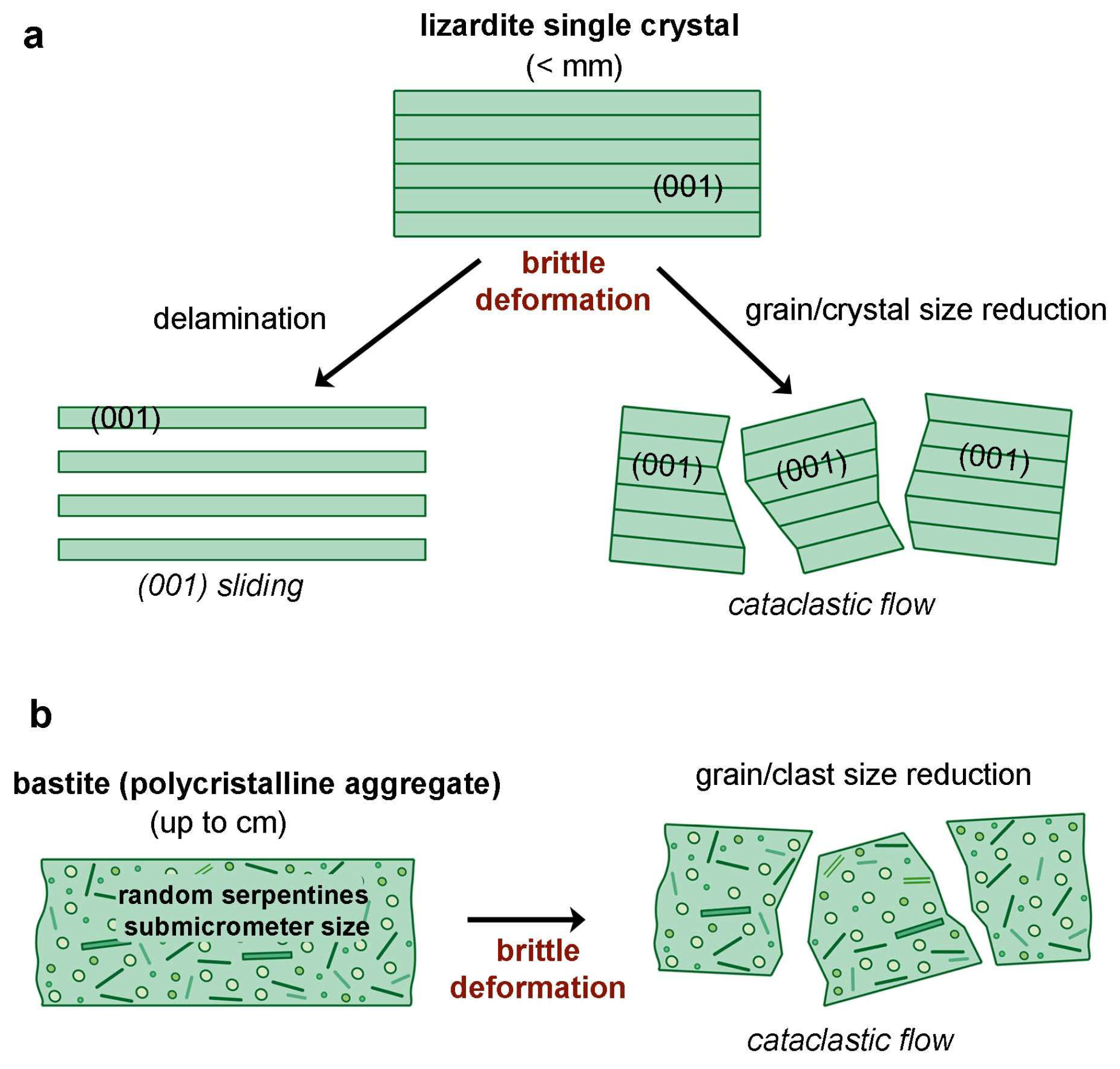
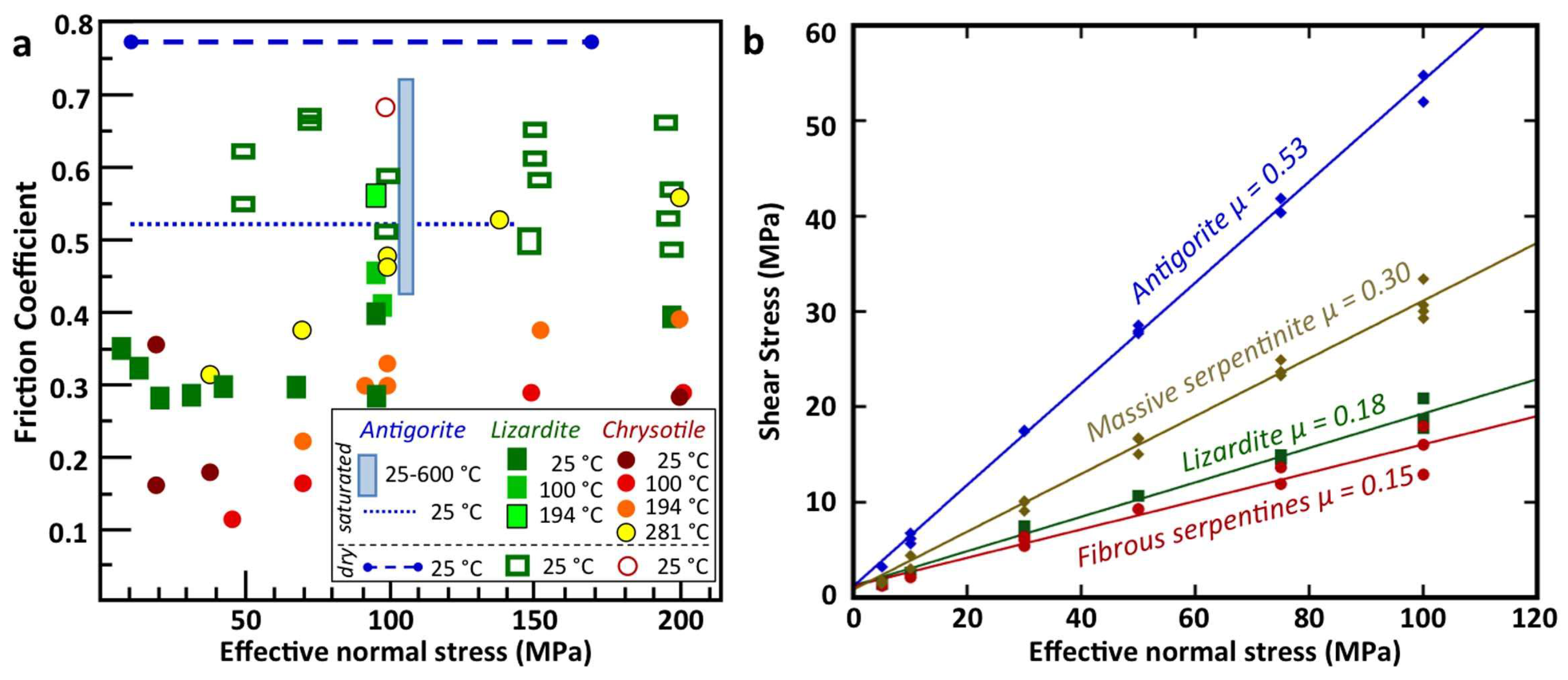
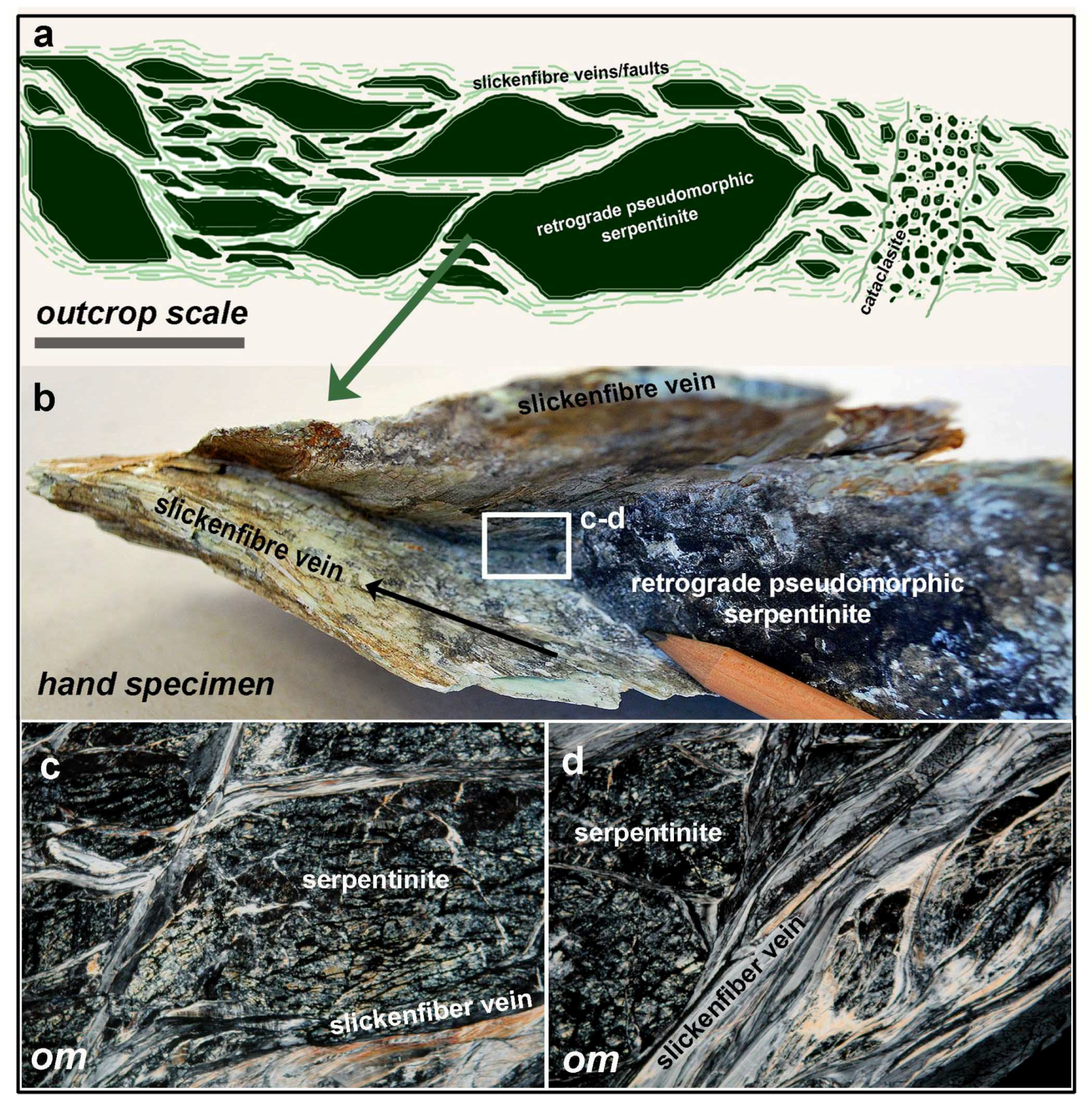
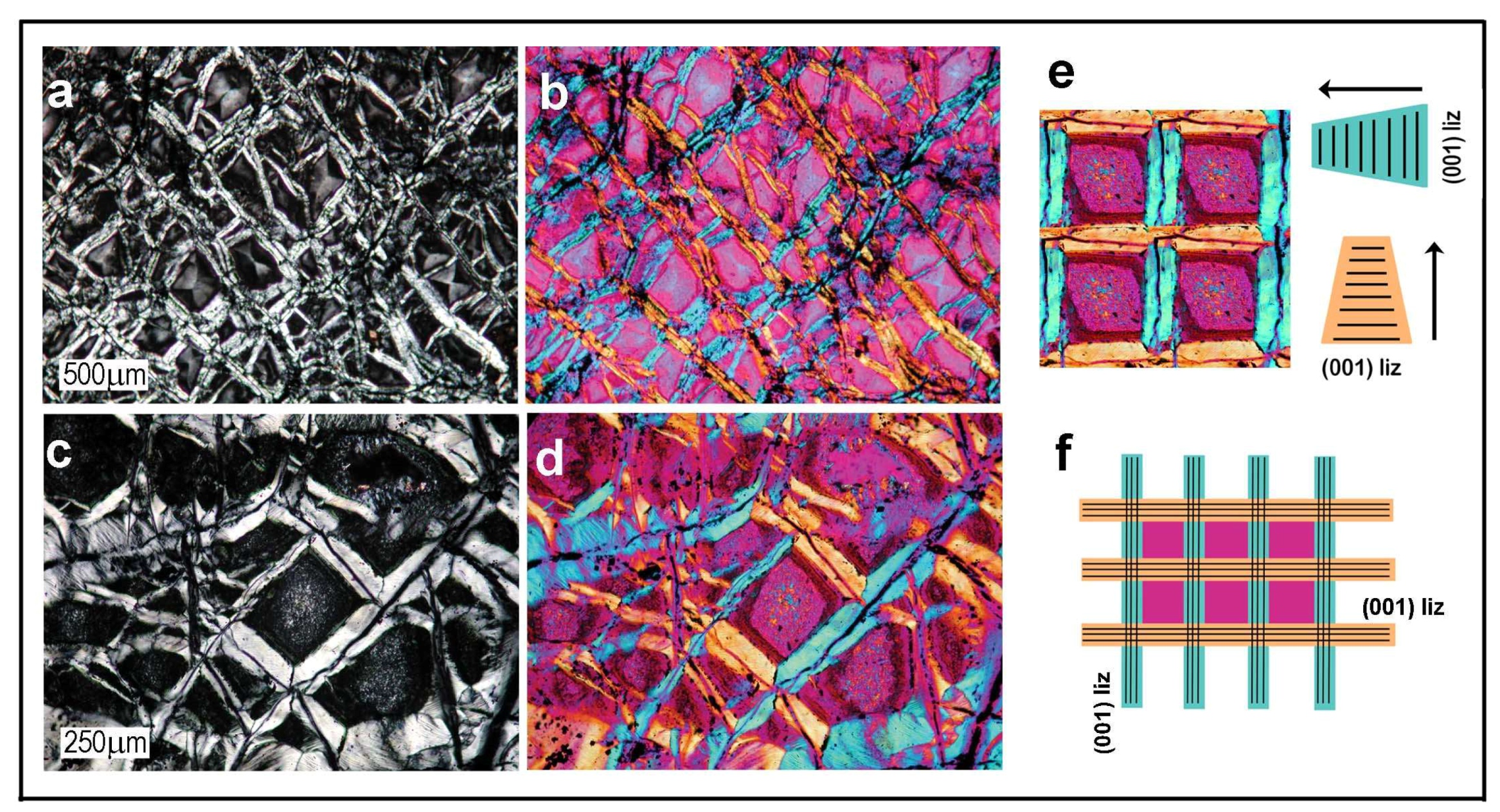
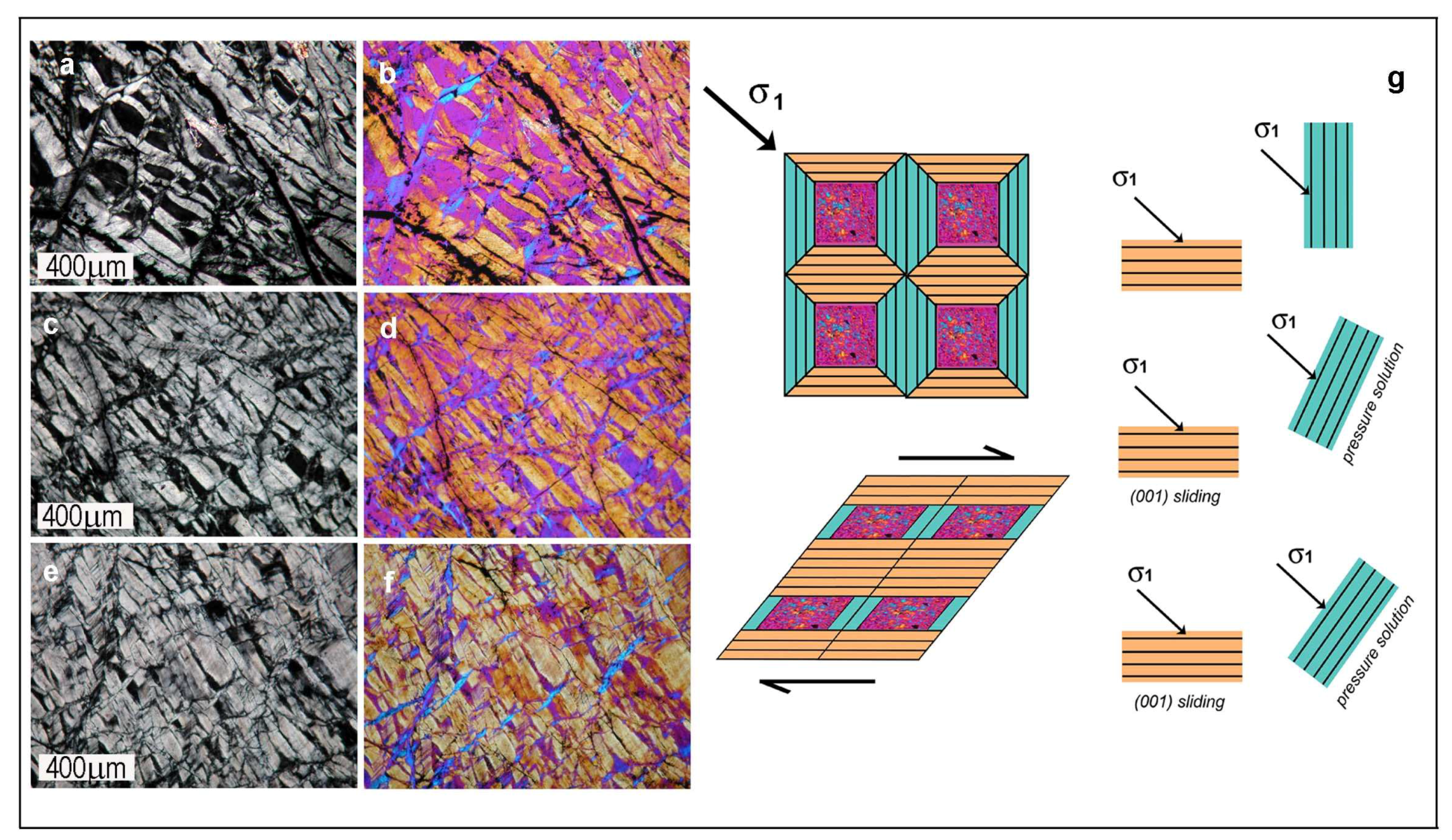

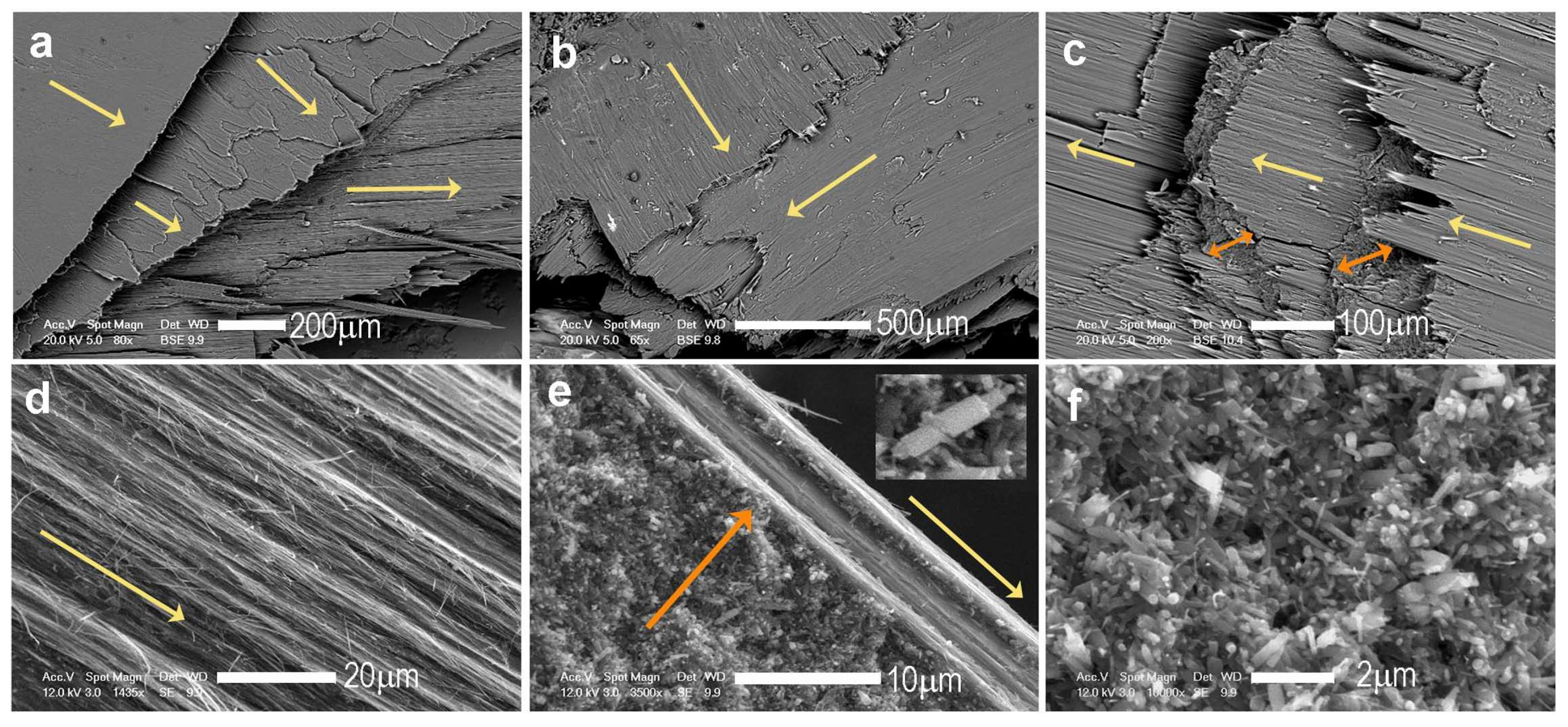
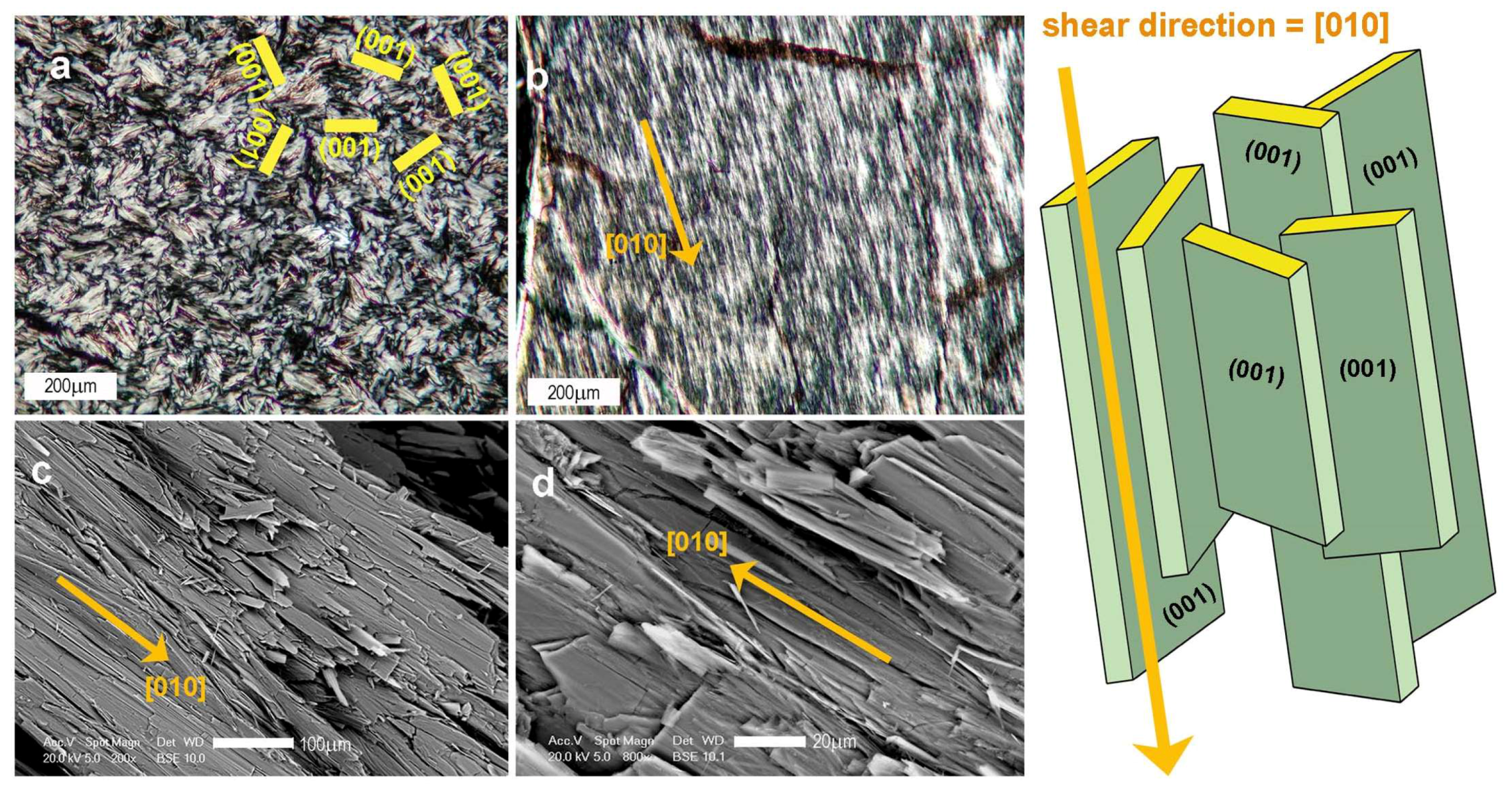
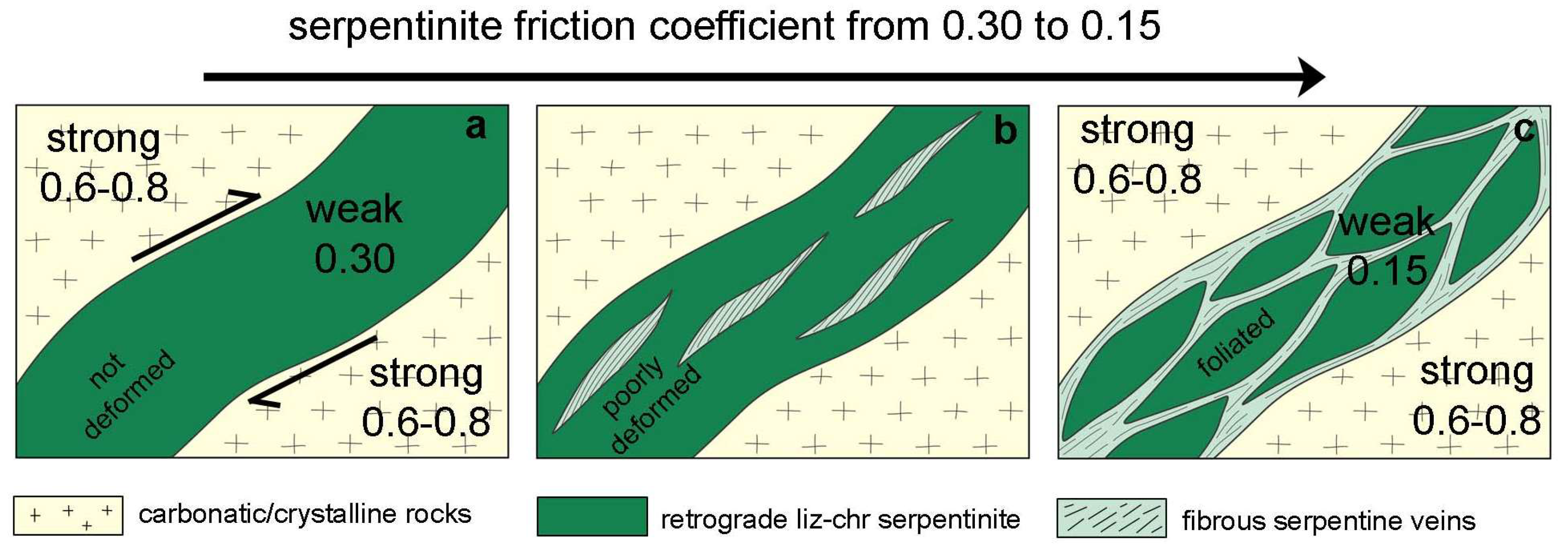
© 2018 by the authors. Licensee MDPI, Basel, Switzerland. This article is an open access article distributed under the terms and conditions of the Creative Commons Attribution (CC BY) license (http://creativecommons.org/licenses/by/4.0/).
Share and Cite
Viti, C.; Collettini, C.; Tesei, T.; Tarling, M.S.; Smith, S.A.F. Deformation Processes, Textural Evolution and Weakening in Retrograde Serpentinites. Minerals 2018, 8, 241. https://doi.org/10.3390/min8060241
Viti C, Collettini C, Tesei T, Tarling MS, Smith SAF. Deformation Processes, Textural Evolution and Weakening in Retrograde Serpentinites. Minerals. 2018; 8(6):241. https://doi.org/10.3390/min8060241
Chicago/Turabian StyleViti, Cecilia, Cristiano Collettini, Telemaco Tesei, Matthew S. Tarling, and Steven A.F. Smith. 2018. "Deformation Processes, Textural Evolution and Weakening in Retrograde Serpentinites" Minerals 8, no. 6: 241. https://doi.org/10.3390/min8060241
APA StyleViti, C., Collettini, C., Tesei, T., Tarling, M. S., & Smith, S. A. F. (2018). Deformation Processes, Textural Evolution and Weakening in Retrograde Serpentinites. Minerals, 8(6), 241. https://doi.org/10.3390/min8060241




